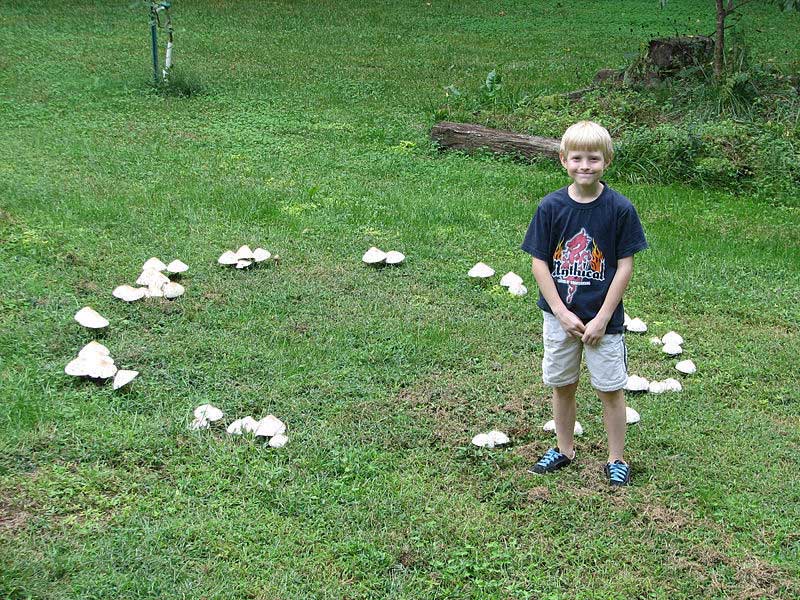RiskVA
Fall Fungus and Fairy Rings, 19 Sep 2018
Along with the welcome rain over the last week or so, fairy rings of mushrooms and other fungal plants are popping up in our lawn. Although they come in a wide variety of colors and shapes. Appearing in a myriad of shapes, sizes and colors, the most typical and recognizable ones are those with a stalk and cap, sometimes called toadstools. But, sorry to say, I’ve never seen toads resting their feet or sitting on them.
Growing up, I was taught that “toadstools” were poisonous and mushrooms were not. That’s wrong. The fact is that toadstools are mushrooms and mushrooms are toadstools. Some are poisonous and some are not.
Around the world, there are both edible mushrooms and deadly fungi. The toxins the deadly ones carry can cause nerve, liver and kidney damage that is irreversible and frequently fatal.
Luckily grocery suppliers apparently know the difference. Food stores are filled with a wide variety of delicious mushrooms, some with caps as large as a small plate. Over the years I have certainly consumed my share of them, sliced, chopped and sautéed in a variety of ways not the least of which is steak smothered in fungus – uh – mushrooms.
The mushrooms you see popping up in the lawn, on dead logs, at the base of trees and other places, are just the fungus fruiting structure and only a small part of the entire plant. A web of virtually invisible widespread, thread-like tendrils called a mycelium has been invisibly living and spreading in the soil or dead wood all year long or for many years.
When conditions are right, usually in spring or fall after rains, the fruiting body we call a mushroom appears from the mycelium, often overnight. These produce dust-like spores that drop either directly under the cap or are carried on the wind like microscopic seeds that sprout and produce new mycelia. A single fungus network in grass or on the forest floor can form a network covering several acres.
Mushrooms appearing singly or in little clusters may be one thing, but what about circles of them? They’re called fairy or pixie rings, and these mystical creatures are reputed to dance within the rings on moonlit nights. And by the way, don’t get me started about the modern day corruption of the word fairy. I like the old-time definition better.
These mushroom circles or fairy rings are at the outer margins of the invisible fungus thread or web that has been there all along. Then almost magically – remember that word - when conditions are right, the visible “toadstool” fungi suddenly sprout in a circle around the edges of the web. In other words, there’s nothing magic about the circle. Or is there?
Tales dating back into antiquity tell of fairies or pixies dancing in the night around or within the circles and using the mushrooms as seats upon which to rest and catch their breath between frolics.
Some stories carry dire warnings of bad luck associated with the rings. To stumble into a fairy ring might bring disease or bad luck. Some people believed that you could be captured by the fairies and drawn down to their underground kingdom into slavery. Dairy farmers were afraid that the milk from cattle grazing within the rings would be sour.
On the other hand some folks believed that building your home in an area where fairy rings abounded would bring good fortune. It was also said that fairies often buried treasure inside the rings. And dew collected from the ring made a powerful love potion. I like these stories but I still haven’t found any buried treasure inside a fairy ring. Rats!
So take your pick this season. Good luck or bad, fortune or famine, I like the idea of fairy rings and hope one night, when tattered clouds drift across a full moon and mist cloaks the glades, to see their flitting fairy dance. Let me know if you do. Perhaps a sip of liquid “moonshine” will help you see them. Just kidding. If we spot them maybe good luck will always follow both of us in our fields and forests.
Dr. Risk is a professor emeritus in the College of Forestry and Agriculture at Stephen F. Austin State University in Nacogdoches, Texas. Content © Paul H. Risk, Ph.D. All rights reserved, except where otherwise noted. Click paulrisk2@gmail.com to send questions, comments, or request permission for use.

